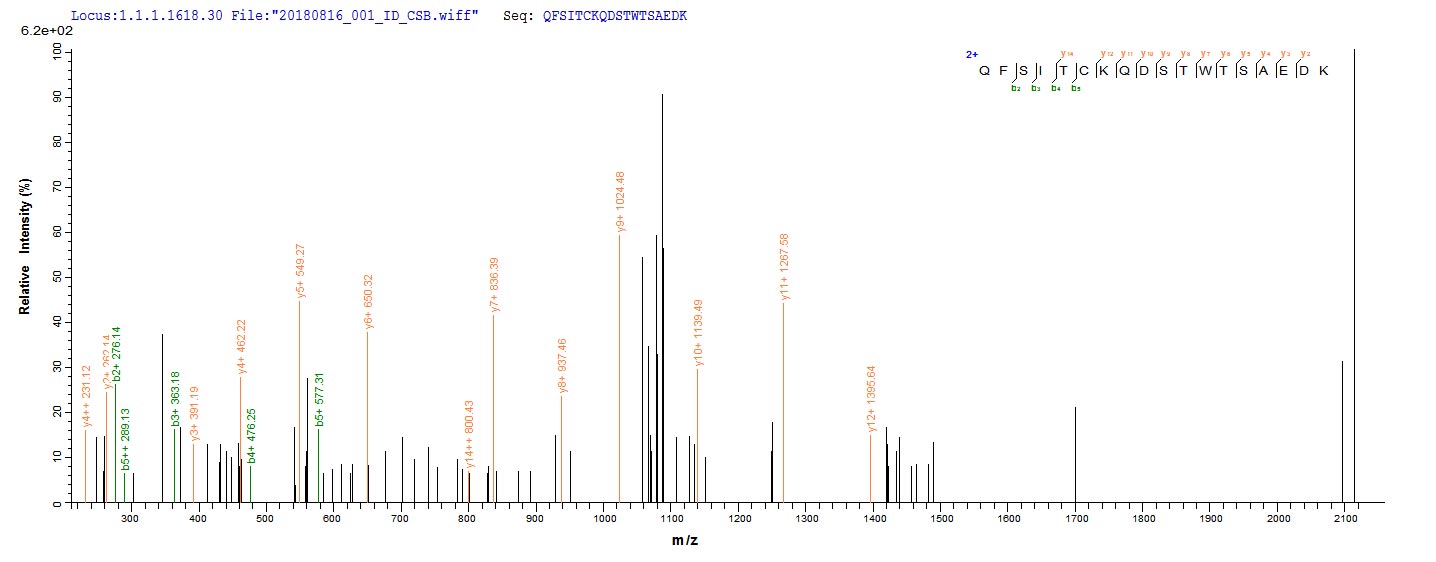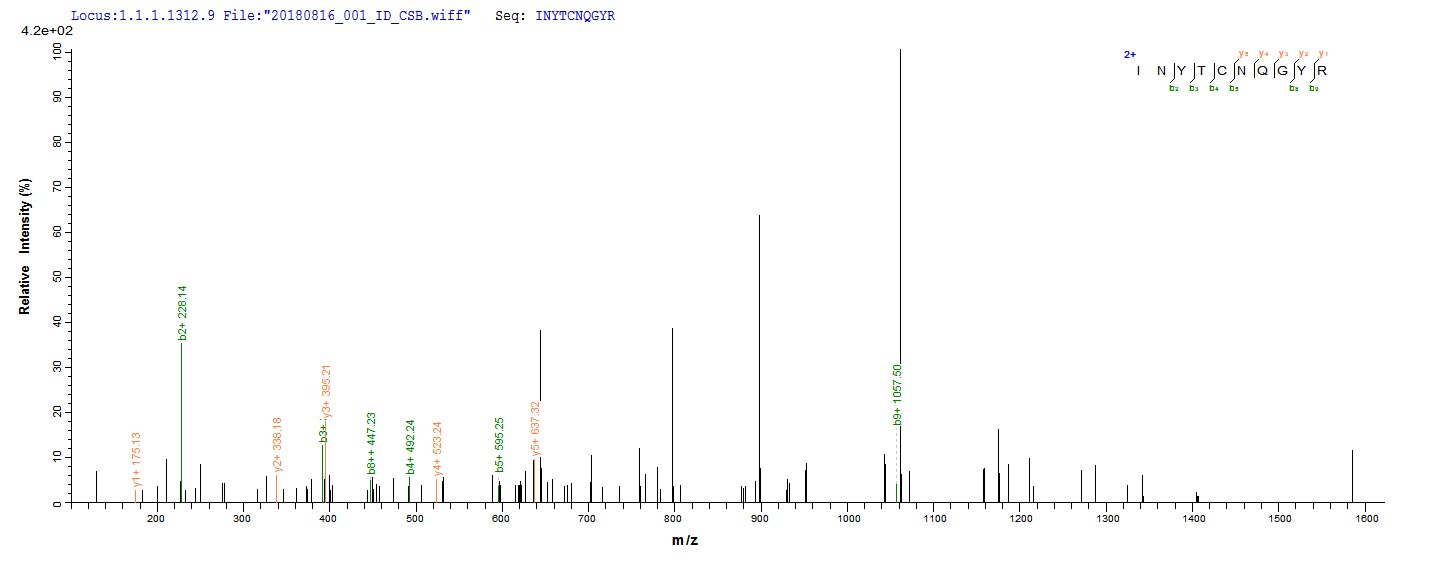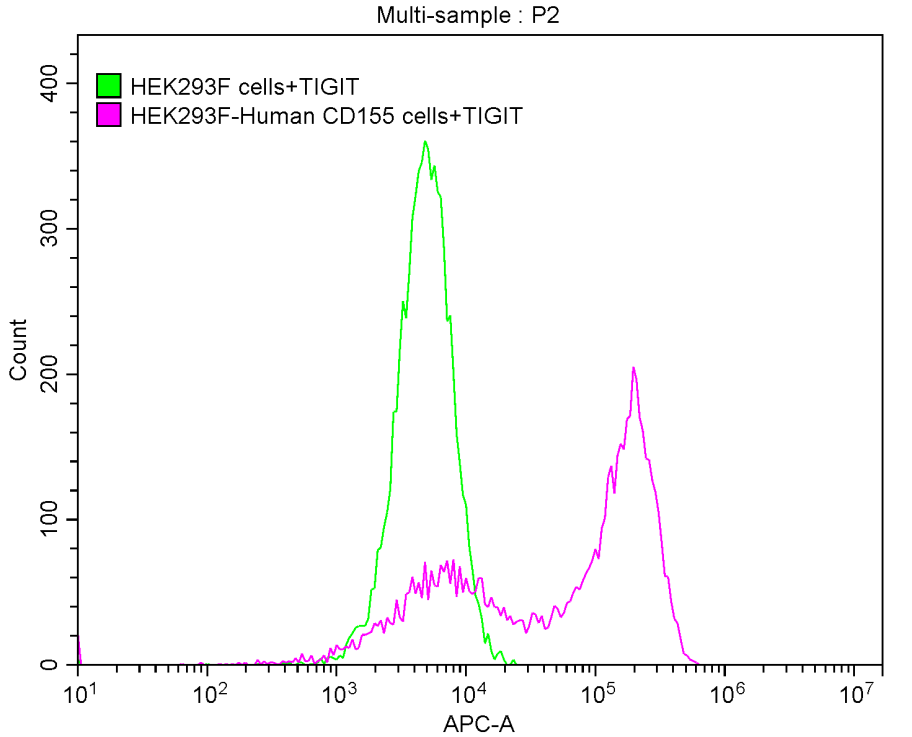Recombinant Mouse Complement component receptor 1-like protein (Cr1l), partial
In Stock-
中文名称:Recombinant Mouse Complement component receptor 1-like protein(Cr1l),partial
-
货号:CSB-EP717575MO1
-
规格:¥1836
-
图片:
-
(Tris-Glycine gel) Discontinuous SDS-PAGE (reduced) with 5% enrichment gel and 15% separation gel.
-
Based on the SEQUEST from database of E.coli host and target protein, the LC-MS/MS Analysis result of CSB-EP717575MO1 could indicate that this peptide derived from E.coli-expressed Mus musculus (Mouse) Cr1l.
-
Based on the SEQUEST from database of E.coli host and target protein, the LC-MS/MS Analysis result of CSB-EP717575MO1 could indicate that this peptide derived from E.coli-expressed Mus musculus (Mouse) Cr1l.
-
-
其他:
产品详情
-
纯度:Greater than 85% as determined by SDS-PAGE.
-
基因名:Cr1l
-
Uniprot No.:
-
别名:Cr1l; Crry; CryComplement component receptor 1-like protein; Complement regulatory protein Crry; Protein p65
-
种属:Mus musculus (Mouse)
-
蛋白长度:Partial
-
来源:E.coli
-
分子量:44.5 kDa
-
表达区域:41-405aa
-
氨基酸序列ELRGGLGKHGHTVHREPAVNRLCADSKRWSGLPVSAQRPFPMGHCPAPSQLPSAKPINLTDESMFPIGTYLLYECLPGYIKRQFSITCKQDSTWTSAEDKCIRKQCKTPSDPENGLVHVHTGIQFGSRINYTCNQGYRLIGSSSAVCVITDQSVDWDTEAPICEWIPCEIPPGIPNGDFFSSTREDFHYGMVVTYRCNTDARGKALFNLVGEPSLYCTSNDGEIGVWSGPPPQCIELNKCTPPPYVENAVMLSENRSLFSLRDIVEFRCHPGFIMKGASSVHCQSLNKWEPELPSCFKGVICRLPQEMSGFQKGLGMKKEYYYGENVTLECEDGYTLEGSSQSQCQSDGSWNPLLAKCVSRSISG
Note: The complete sequence including tag sequence, target protein sequence and linker sequence could be provided upon request. -
蛋白标签:N-terminal 6xHis-tagged
-
产品提供形式:Liquid or Lyophilized powder
Note: We will preferentially ship the format that we have in stock, however, if you have any special requirement for the format, please remark your requirement when placing the order, we will prepare according to your demand. -
缓冲液:Tris-based buffer,50% glycerol
-
储存条件:Store at -20°C/-80°C upon receipt, aliquoting is necessary for mutiple use. Avoid repeated freeze-thaw cycles.
-
保质期:The shelf life is related to many factors, storage state, buffer ingredients, storage temperature and the stability of the protein itself.
Generally, the shelf life of liquid form is 6 months at -20°C/-80°C. The shelf life of lyophilized form is 12 months at -20°C/-80°C. -
货期:3-7 business days
-
注意事项:Repeated freezing and thawing is not recommended. Store working aliquots at 4°C for up to one week.
-
Datasheet & COA:Please contact us to get it.
相关产品
靶点详情
-
功能:Acts as a cofactor for complement factor I, a serine protease which protects autologous cells against complement-mediated injury by cleaving C3b and C4b deposited on host tissue. Also acts as a decay-accelerating factor, preventing the formation of C4b2a and C3bBb, the amplification convertases of the complement cascade. Plays a crucial role in early embryonic development by maintaining fetomaternal tolerance. Also acts as a costimulatory factor for T-cells which favors IL-4 secretion.
-
基因功能参考文献:
- CRRY role in the retinal epithelium and photoreceptor degeneration PMID: 28348233
- this study has provided direct evidence for a role of Crry in controlling spontaneous alternative pathway complement activation on renal tubular epithelial cells. PMID: 24850152
- Crry costimulation enhanced the in vitro expansion of natural Treg cells while maintaining their phenotypic and suppressive properties. Crry-expanded Treg cells decreasing antigen-dependent secretion of cytokines. PMID: 21380996
- Stmn2 and the chromosome 14 Rarb region, but not Cr1 or Clu or Picalm, have roles in prion disease. PMID: 21151910
- Crry is clearly present in the placentas from spontaneous abortions in mice. PMID: 20484840
- Crry is the only membrane-bound complement regulator expressed on the basolateral surface of murine renal tubular epithelial cells under in vitro culture conditions. PMID: 20675597
- Data show that a single-nucleotide polymorphism in the first short consensus repeat of Sle1c Crry introduced a novel N-linked glycosylation site likely responsible for structural alteration. PMID: 20660348
- mesangial cell Crry limits complement activation and subsequent neutrophil recruitment in the setting of local immune complex deposition. PMID: 19740350
- Long-term complement blockade with Crry, a C3 convertase inhibitor overexpressed in a transgenic mouse line, reduces renal disease and improves survival in lupus-prone MRL/lpr mice. PMID: 11907125
- the role of crry in regulating complement regulation PMID: 11915940
- Crry is indispensable for erythrocyte protection from spontaneous complement attack PMID: 11986227
- Crry plays a more dominant role than DAF in regulating the alternative pathway of complement C3 activation, whereas DAF and Crry are equally effective in preventing antibody-induced runaway complement activation. PMID: 12393518
- X-ray and neutron scattering was performed on recombinant rat Crry containing the first five SCR domains (rCrry) and mouse Crry with five SCR domains conjugated to the Fc fragment of mouse IgG1 (mCrry-Ig) PMID: 12767833
- Mice transgenic for murine complement inhibitor Crry are largely protected from developing collagen-induced arthritis. PMID: 12902517
- Data demonstrate that transgenic mice with astrocyte-targeted expression of the soluble complement inhibitor sCrry have a significantly reduced neurologic impairment and improved blood-brain barrier function after closed head injury. PMID: 12973023
- The dual function of Crry as a complement regulatory protein and as a T cell costimulator illustrates the importance of complement regulatory proteins as links between innate and adaptive immunity. PMID: 16301324
- Results suggest that altered expression of Crry within the tubular epithelium appears to be a critical factor permitting activation of the alternative pathway of complement after ischemia/reperfusion. PMID: 16444293
- both a high level expression and a more potent anti-alternative pathway complement activity of Crry contributed to its indispensable role on murine erythrocytes PMID: 17015743
- Our data suggest complement provides some protection of mature oligodendrocytes during cuprizone treatment but may be critical for subsequent remyelination events. PMID: 17674370
- DAF and Crry double deficiency led to rapid clearance of platelets from circulation in a complement- and macrophage-dependent manner; redundant role of DAF and Crry in platelet survival PMID: 18524992
- Membrane complement regulator Crry helps to maintain homeostasis of the complement alternative pathway (AP) and demonstrates that Crry-deficient mice can be rescued on a partial as well as on a complete factor B- or C3-deficient maternal background. PMID: 18684964
- Pak1 is an essential molecular target for modulating acute mast cell responses that contribute to allergic diseases. PMID: 19124833
- Crry is essential for mature T-cell survival in the periphery but not for lymphogenesis in the thymus. PMID: 19136662
- Crry and CD59 are critical in protecting Treg cells from complement mediated injuries. PMID: 19281793
显示更多
收起更多
-
亚细胞定位:Membrane; Single-pass type I membrane protein.
-
蛋白家族:Receptors of complement activation (RCA) family
-
组织特异性:Ubiquitously expressed (at protein level).
-
数据库链接:
KEGG: mmu:12946
UniGene: Mm.301652
Most popular with customers
-
Recombinant Human T-cell immunoreceptor with Ig and ITIM domains (TIGIT), partial (Active)
Express system: Mammalian cell
Species: Homo sapiens (Human)
-
Recombinant Human Dickkopf-related protein 1 (DKK1) (Active)
Express system: Mammalian cell
Species: Homo sapiens (Human)
-
Recombinant Human Alkaline phosphatase, germ cell type (ALPG) (Active)
Express system: Mammalian cell
Species: Homo sapiens (Human)
-
Recombinant Human C-type lectin domain family 4 member C (CLEC4C), partial (Active)
Express system: Mammalian cell
Species: Homo sapiens (Human)
-
Recombinant Human CD81 antigen (CD81), partial (Active)
Express system: Mammalian cell
Species: Homo sapiens (Human)
-
Recombinant Human Cytotoxic and regulatory T-cell molecule (CRTAM), partial (Active)
Express system: Mammalian cell
Species: Homo sapiens (Human)
-
Recombinant Human C-C chemokine receptor type 9 (CCR9)-VLPs (Active)
Express system: Mammalian cell
Species: Homo sapiens (Human)






-AC1.jpg)















